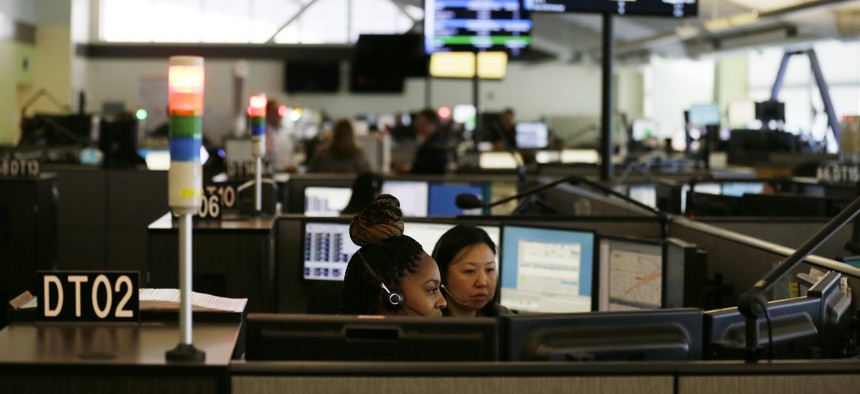How Emerging Tech Could Help Ease Stress on 911 Call Center Staff

The San Francisco 911 call center. Emerging technology can help ease the stress and trauma experienced by 911 call center professionals. AP PHOTO/ERIC RISBERG
COMMENTARY | Technology could play a key role in reducing stress and trauma that can be a challenge for the workers who answer emergency phone lines.
At some point in all of our lives, we’ll experience some type of traumatic event. For first responders, such as 911 call center professionals, traumatic experiences are almost a daily occurrence. Despite the gravity of these situations, operators must stay calm and collect as much information as possible from the caller to determine the right action and resources, then assign and alert first responders to the field. This is no easy task. A 911 call-taker’s position isn’t your typical 9 to 5 job. And the events they encounter aren’t easily left behind at the end of a shift, which can lead to serious mental trauma.
Fortunately, there are ways emerging technology can help reduce the mental stress on emergency communications center staff.
A Growing Concern
Exposure to traumatic events might be considered an occupational hazard of being a first responder to some. However, prolonged and repeated exposure to such events can lead to an increased rate of post-traumatic stress disorder (PTSD) among these professionals. A study by the U.S. National Library of Medicine and National Institutes of Health found that first responders were at a greater risk of developing PTSD than the average person in the following intervals:
- Law enforcement: 6%-32%
- Emergency medical technicians/paramedics: 9%-22%
- Firefighters: 17%-32%
A separate study by Dr. Michelle Lilly, which focused specifically on the prevalence of PTSD in emergency phone line operators, found that 18%-24% of these professionals exhibit PTSD symptoms. Among those surveyed, the most stressful calls were the unexpected injury or death of a child (16.4%), suicidal callers (12.9%), shootings involving officers (9.9%) and calls involving the unexpected death of an adult (9.9%).
Lilly’s research went further and also pinpointed the many causes of stress within a communications center, including:
- Novelty: A chronic exposure to things that are novel or new.
- Nonpredictive outcomes: When events happen out of sequence or aren’t predictable.
- Loss of control: Sensing a lack of power, which can increase anxiety.
- Social evaluation: Having others watch or judge performance.
Additionally, a feeling of helplessness and guilt about a negative outcome can contribute to mental and emotional stress. If a person dies, first responders on the scene sometimes blame themselves and assume they could’ve done more. But Lilly believes the feeling of guilt is worse for 911 professionals because they are physically separated from the scene as they still hear the sounds of fear and experience mental stress from picturing the events in their minds.
Potential Impacts of Technology
The next generation of computer-aided dispatch (CAD) systems, when integrated with analytics and records management systems (RMS), could reduce stress by enabling supervisors to monitor and balance workloads for call-takers as well as personnel in the field. Reports can be used to determine if some call-takers are working longer hours or if staffing levels on shifts are misaligned with peak call volume times. Mobile solutions also would allow first responders to handle many information requests and updates, which would cut 911 call-takers’ workload communicating with units in the field.
Additional benefits that help to reduce the burden on call-takers include improved workflows and increased visibility into situations in the field, such as better communication when there is a language barrier and ability to relay pertinent, timely information about the scene to responding units. For example, if the caller has been in a traffic accident and there is confusion about the actual location, a call-taker using traffic cameras integrated with the CAD map displaying the caller’s location could quickly verify the exact location, improving unit routing and decreasing response time.
The concept of integrating live camera feeds into CAD systems might seem far off, but the practice is already in use in agencies in the U.S. and Europe. The technology provides complete situational awareness and threat detection, both of which enable more informed decision-making.
It’s not yet known how communications centers will be affected by the integration of cameras near an incident scene and/or the ability to receive photos and videos from callers. While some call-takers could face additional trauma from viewing scenes from an emergency, Lilly believes seeing an event first-hand reduces mental stress. It’ll be incumbent on communications center managers to ensure their employees have appropriate staffing capacity, training to analyze video and access to adequate mental health resources. There are a number of resources available to help call-takers, including mental health counseling, peer support, employee assistance programs, self-care and national organizations like the All Clear Foundation. Additionally, some CAD solutions can be configured to include immediate access to mental health resources following a traumatic event. The capabilities and ease of use of those solutions could improve worker well-being for all employees, especially call-takers.
Operators at 911 call centers are on the front lines of traumatic situations on a regular basis. Unchecked PTSD can lead to employee burnout, physical illness and suicide. It also impacts public safety, whether through increased dispatching errors or the loss of experience and capacity due to staff churn.
While the latest dispatch tools and myriad mental health resources alone won’t reduce the number of traumatic calls, they can support 911 personnel who often suffer in silence when their jobs require them to guide anxious and frightened callers through life-changing events.
Chris Carver is the director of sales (East) at Hexagon’s Safety & Infrastructure division.
NEXT STORY: Occupational Licensing Reforms Must Maintain Standards to Protect the Public





